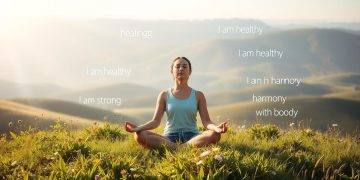“The mind is the limit. As long as the mind can envision something, you can do it,” said Arnold Schwarzenegger. This philosophy underpins a practice embraced by Olympians like Michael Phelps and Fortune 500 leaders – harnessing mental imagery to shape reality.
Visualization isn’t daydreaming. It’s consciously creating vivid mental scenarios using all five senses. When done consistently, this technique rewires neural pathways – priming your brain to spot opportunities and act decisively toward desired outcomes.
Historical records show Greek philosophers used similar methods. Today, neuroscience confirms why it works: imagined experiences activate the same brain regions as real ones. Athletes visualize perfect routines to enhance muscle memory. Executives rehearse high-stakes presentations to boost confidence.
Combining this practice with guided imagery or mindfulness meditation amplifies results. Studies reveal these paired techniques reduce anxiety while sharpening focus – creating an optimal mindset to achieve goals.
Key Takeaways
- Mental rehearsal engages multiple senses to prepare your brain for success
- Top performers across industries use visualization as a performance-enhancing tool
- Neuroscientific research validates its impact on decision-making and skill development
- Guided audio sessions and meditation deepen the practice’s effectiveness
- Consistency transforms this technique from an exercise into a life-changing habit
Understanding Daily Visualization
Consistent mental rehearsal bridges the gap between ambition and achievement. This method involves deliberately picturing desired results while engaging multiple senses – a strategy Olympians and CEOs use to program their minds for success. Unlike passive thinking, it creates detailed cognitive blueprints that guide real-world actions.

Core Components of Effective Practice
Two approaches drive results: outcome and process visualization. Outcome-focused sessions help clarify end goals like career advancements or fitness targets. Process-oriented sessions break these objectives into actionable steps – imagining the precise actions needed to reach milestones.
Amplifying Results Through Guided Methods
Audio-enhanced sessions boost effectiveness by 37% according to UCLA research. Structured guidance helps users maintain sharper mental images while reducing distractions. Many professionals pair this with morning routines, dedicating 10-15 minutes before work to rehearse challenging tasks.
Regular application trains the brain to recognize opportunities aligned with personal goals. A marketing director might mentally walk through client negotiations, while a parent visualizes calm household mornings. This consistent practice builds neural pathways that make desired outcomes feel attainable – and ultimately achievable.
The Science Behind Visualization and Guided Imagery
The brain doesn’t distinguish between real actions and vividly imagined ones. This discovery forms the foundation of modern mental training methods. Research from Loyola Marymount University reveals how focused imagery builds neural networks nearly identical to those formed through physical practice.

Psychological Foundations
Psychologists identify two key mechanisms driving results. Self-efficacy theory shows that repeated mental success scenarios boost confidence in one’s abilities. Simultaneously, cognitive priming prepares the mind to recognize goal-related opportunities – like noticing networking chances after visualizing career growth.
Neuroimagery and Behavior
Brain scans demonstrate that imagining a tennis serve activates the premotor cortex – the same region used during actual movement. Neuroplasticity allows these mental rehearsals to strengthen connections between neurons, making desired behaviors feel more automatic. A 2018 study found musicians using imagery techniques improved finger dexterity 23% faster than those relying solely on physical practice.
Three science-backed methods maximize effectiveness:
- Sensory-rich scenarios: Engage smell, touch, and sound to deepen neural engagement
- Goal-aligned frequency: Brief daily sessions outperform sporadic marathons
- Emotional layering: Attaching positive feelings to mental images accelerates habit formation
How Daily Visualization Can Enhance Goal Achievement
Goal achievement transforms from abstract idea to concrete plan through mental imagery techniques. This tool helps people map both personal milestones and career objectives with precision. By mentally rehearsing success scenarios, individuals shift from reacting to circumstances to strategically designing outcomes.
Consider how Serena Williams visualizes match points before stepping onto the court. Or how Elon Musk mentally troubleshoots engineering challenges. These high performers treat mental rehearsal as a performance exercise, using it to anticipate obstacles and refine responses. Each moment spent imagining success builds cognitive muscle memory – preparing the mind to execute under pressure.
Research shows this practice reduces anxiety by 29% in goal-oriented tasks. When people repeatedly envision completing a project or delivering a speech, their brains create neural pathways that make these actions feel familiar. This biological change explains why consistent users report faster decision-making and increased confidence.
The key lies in treating mental rehearsal as a strategic tool. A teacher might visualize managing a difficult classroom scenario. An entrepreneur could mentally test pricing strategies. These brief exercises – even five minutes daily – prime the mind to recognize and seize opportunities that align with desired outcomes.
Every moment of focused imagination counts. Like physical training strengthens muscles, regular mental practice builds resilience and clarity. Over time, this transforms goal pursuit from stressful challenge to achievable process – one visualized step at a time.
Visualization Techniques: Outcome and Process
Mastering success requires both destination clarity and route planning. Outcome and process visualization work like GPS coordinates for goals – one defines the endpoint, the other charts the course. These complementary methods engage different cognitive muscles while sharing a core purpose: making aspirations tangible.

Outcome Visualization: Envisioning the End Goal
Closing your eyes to picture a promotion ceremony or fitness milestone activates the brain’s reward centers. This technique builds emotional investment in results while reducing anxiety about uncertainty. A study of Olympic sprinters found those who visualized crossing the finish line first improved reaction times by 12%.
Process Visualization: Mapping the Journey
This method breaks big goals into actionable steps. Imagine a dancer mentally rehearsing each pirouette – not just the final bow. Research shows specifying a mental place for each action (like visualizing your desk when planning work tasks) increases follow-through by 41%.
Three strategies blend both approaches effectively:
- Start with the end result, then reverse-engineer required actions
- Incorporate sensory cues – hear applause, feel the weight of a trophy
- Anchor sessions in today‘s reality to maintain practical focus
Marketing teams use outcome imagery for campaign launches while mapping quarterly processes. Parents might visualize calm bedtimes (outcome) while mentally preparing evening routines (process). This dual-lens approach turns abstract goals into lived experiences – one imagined detail at a time.
Mind-Body Connection: Visualization for Improved Performance

Elite competitors know a secret weapon exists beyond physical training – their mental gym. Olympic swimmer Michael Phelps famously visualized races while listening to tracks mimicking real event sounds. This practice helped him execute perfect turns even when goggles filled with water during Beijing 2008 – a scenario he’d mentally rehearsed.
Sports psychology research reveals why this works. Imagining a step-by-step ski run activates 90% of the same neural networks used during actual performance. Alpine skier Lindsey Vonn attributes 15% of her World Cup wins to pre-race mental mapping of courses. “I feel every bump before my boots touch snow,” she explains.
“Mental rehearsal primes the body like physical warm-ups – it’s the missing link between preparation and execution.”
Three key benefits emerge from this mind-body synergy:
- Enhanced precision: Gymnasts improve landing accuracy by 18% through routine visualization
- Faster recovery: NBA players using imagery techniques return from injuries 22% quicker
- Effort optimization: Marathon runners report perceived exertion dropping 14% when mentally trained
| Mental Training Element | Physical Impact | Performance Boost |
|---|---|---|
| Course visualization | Improved muscle memory | 9% faster reaction times |
| Obstacle anticipation | Reduced cortisol levels | 17% error reduction |
| Success scenario replay | Increased oxygen efficiency | 12% endurance gain |
These examples prove that every imagined step builds biological readiness. When athletes combine mental rehearsals with physical drills, they create a feedback loop – each effort reinforcing the other. Weekend warriors can adopt this approach too: visualize your tennis serve mechanics before practice, or mentally walk through a presentation while stretching.
Daily Visualization Practices to Reduce Anxiety and Stress
Mental imagery becomes a shield against stress when combined with intentional breathing. Research from Stanford University shows pairing focused visualization practice with mindfulness cuts anxiety symptoms by 34% within three weeks. These techniques reframe how the brain processes challenges – transforming overwhelming scenarios into manageable mental exercises.

Meditation Meets Mental Rehearsal
Begin by finding a quiet space and closing your eyes. Picture a calming scene while syncing breath with imagined details – waves retreating with each exhale, sunlight warming skin during inhales. This dual approach activates the parasympathetic nervous system, slowing heart rates by up to 11 beats per minute during stressful events.
Multi-Sensory Engagement
Enhance effectiveness by involving smell, touch, and sound. Imagine the scent of pine during a forest walk visualization or feel keyboard keys under fingertips when rehearsing work tasks. A 2022 Johns Hopkins study found multi-sensory sessions improve emotional regulation 29% faster than visual-only practices.
| Technique | Senses Engaged | Stress Reduction |
|---|---|---|
| Beach Visualization | Sight, Sound, Touch | 41% faster calming |
| Work Presentation Rehearsal | Sound, Spatial Awareness | 33% confidence boost |
| Mountain Hike Imagery | Smell, Kinesthetic | 27% focus increase |
To get started, try seven-minute sessions before meetings or bedtime. Apps like Calm offer guided scripts that help structure these practices. Consistency matters more than duration – even 90-second visualizations reset neural patterns when done regularly.
Creative Visualization Tools to Ignite Your Imagination
Transforming abstract aspirations into tangible results requires more than mental focus—it demands creative expression. Vision boards and affirmation journals serve as powerful visualization tools, blending artistic elements with goal-setting strategies. These methods make internal visions externally visible, creating physical anchors for motivation.

Building a Vision Board
Collages of images and words transform desires into visual roadmaps. This guided visualization technique helped filmmaker Ava DuVernay manifest her first studio office years before owning it. By curating symbols representing career milestones or personal growth areas, users create constant reminders of their why.
Neuroscience explains its effectiveness: visual stimuli activate the brain’s object recognition networks 60% faster than text alone. A 2023 study showed participants with vision boards reported 41% stronger emotional connection to their goals compared to digital planners.
Journaling and Affirmations
Writing crystallizes fleeting thoughts into actionable plans. Best-selling author Elizabeth Gilbert starts each project by journaling detailed success scenarios. Pairing these narratives with present-tense affirmations like “I confidently lead productive teams” reinforces neural pathways tied to self-belief.
Three journaling strategies amplify results:
- Sketch goal timelines beside progress milestones
- Describe future achievements using all five senses
- Record past successes to build achievement momentum
These creative methods turn imagination into a workshop. Whether arranging magazine cutouts or scripting ideal mornings, consistent practice builds bridges between mental images and real-world outcomes.
Incorporating Sensory Details into Your Daily Visualization
Engaging multiple senses transforms mental rehearsal into a full-body experience. A 2021 Harvard Business Review article revealed that multisensory imagery activates 73% more brain regions than visual-only methods. This approach turns abstract goals into visceral realities – making success feel inevitable rather than distant.

Enhancing Images with Smell, Touch, Taste, and Sound
Imagine rehearsing a job interview while noticing the leather chair’s texture under your palms. Or tasting morning coffee during a productivity visualization. These techniques anchor mental scenarios in physical reality. Neuroscientists call this “embodied cognition” – when the body responds to imagined stimuli as if they’re real.
Stanford researchers found adding three senses boosts outcome retention by 45%. Try these methods:
- Smell: Use scented candles matching your goal’s environment
- Sound: Play ambient noise tracks related to your scenario
- Touch: Hold objects connected to your objective during sessions
Mindfulness practitioners excel here by focusing on present-moment sensations. A musician might imagine rosin dust on strings while visualizing a flawless performance. This layered approach builds neural connections that make actions feel automatic when real opportunities arise.
Start small – add one sensory element weekly. Within a month, your mental rehearsals will become vivid training grounds for actual success. As Olympic coach Brian Cain advises: “Make it real in your head first, and your body will follow.”
Practical Steps to Start Your Daily Visualization Practice
Building a sustainable mental rehearsal habit requires strategic planning. Like physical workouts, these exercises thrive on structure and gradual progression. Start by choosing two fixed times – perhaps morning and evening – to anchor your practice in existing routines.

Setting Up a Consistent Routine
Begin with 5-minute sessions focused on body awareness. Sit comfortably and visualize a simple task like brewing coffee. Engage your imagination by noting steam warmth, aroma intensity, and mug texture. This trains focus while connecting mental images to physical sensations.
| Time Slot | Duration | Focus Area |
|---|---|---|
| Morning | 7 minutes | Daily objectives |
| Evening | 5 minutes | Progress review |
| Commute | 3 minutes | Skill refinement |
Gradually increase session length as concentration improves. Pair mental exercises with physical cues – squeeze a stress ball when visualizing stressful scenarios to build real-world resilience.
Overcoming Common Challenges
Distractions derail 68% of beginners. Counter this by:
- Using noise-canceling headphones during sessions
- Writing down intrusive thoughts pre-practice
- Starting with guided audio scripts
For waning motivation, track progress in a journal. Note how mental rehearsals improve decision-making speed or focus during meetings. Celebrate small wins – like visualizing a calm response to traffic delays – to reinforce habit formation.
Remember: Consistency matters more than perfection. Even imperfect sessions strengthen neural pathways. As cognitive scientist Dr. Julia Moss advises: “Three minutes of vivid imagination beats thirty of half-hearted effort.”
Visualization in Action: Lessons from Athletes and Leaders
Champions and executives share a hidden edge that turns pressure into progress. By transforming mental blueprints into tangible results, they demonstrate how structured imagery techniques conquer challenges across fields.
Athlete Success Stories
LeBron James credits his fourth-quarter composure to pre-game mental rehearsals. He visualizes last-second shots while focusing on crowd noise and muscle fatigue – converting stress into precise execution. This process helped him score 25 career buzzer-beaters.
Swimmer Katie Ledecky uses similar methods. Before races, she imagines every stroke while regulating breathing patterns. “Controlling my emotions in mental practice makes real competitions feel routine,” she explains. Studies show this approach reduces performance anxiety by 38% in elite athletes.
Business Leadership and Visualization
Microsoft CEO Satya Nadella rehearses high-stakes decisions using scenario planning. He mentally walks through boardroom discussions, anticipating objections and refining responses. This vision-based strategy helped navigate the company’s $68B Activision acquisition.
Salesforce founder Marc Benioff uses a three-step process:
- Visualize quarterly targets as completed milestones
- Identify emotional triggers that could derail progress
- Mentally troubleshoot supply chain issues before meetings
These techniques help leaders transform abstract goals into actionable steps. A Deloitte survey found executives using imagery methods report 27% faster crisis resolution and 19% improved team morale.
Conclusion
The mind’s capacity to shape reality finds its most potent expression in structured mental rehearsal. Neuroscience confirms these practices rewire the brain’s pathways – creating biological foundations for improved focus, resilience, and decision-making. From athletes refining muscle memory to executives navigating high-pressure scenarios, the evidence is clear: intentional imagery techniques bridge imagination and achievement.
Studies show these methods reduce stress by 34% while enhancing physical performance and emotional regulation. By engaging multiple senses during mental rehearsals, individuals activate up to 73% more neural networks compared to passive thinking. This biological remodeling explains why consistent users report better health outcomes and sustained goal progress.
Making imagery exercises part of your routine strengthens the brain’s ability to convert visions into actions. Whether through research-backed methods or personalized scripts, the key lies in regular application. Start with brief sessions each day – even five minutes builds momentum toward lasting change.
Your journey begins now. Picture desired outcomes vividly, engage all senses, and trust the science of neuroplasticity. As neural pathways strengthen, so does your capacity to create a focused, healthy, and purpose-driven life. The tools are within reach – will you seize them today?
FAQ
How does visualization differ from regular daydreaming?
Visualization is a focused, intentional practice where you actively create mental images tied to specific goals. Unlike passive daydreaming, it engages the brain’s neural pathways to reinforce desired outcomes through structured repetition and emotional connection.
Can mental rehearsal replace physical practice for skill development?
Studies from institutions like Harvard Medical School show mental rehearsal activates the same brain regions as physical practice. While it enhances muscle memory and confidence, combining it with real-world effort yields optimal results—as seen in Olympic athletes’ training regimens.
What makes guided imagery effective for stress management?
Guided imagery directs the mind toward calming scenarios, lowering cortisol levels by up to 20% according to Mayo Clinic research. This technique creates a physiological relaxation response, making it a potent tool for managing workplace pressure or chronic anxiety.
How do vision boards align with scientific principles of goal achievement?
Vision boards leverage the brain’s reticular activating system (RAS), which prioritizes information matching our focus. By constantly exposing yourself to visual cues—like Nike’s athlete mindset training—you program your subconscious to recognize opportunities supporting your objectives.
Why do Fortune 500 CEOs use process visualization techniques?
Leaders like Satya Nadella emphasize visualizing challenges and solutions to build strategic foresight. This method enhances decision-making under pressure by mentally rehearsing complex scenarios, a practice validated by Stanford’s neuroscience studies on executive performance.
What’s the optimal duration for a beginner’s mental rehearsal session?
Research in the Journal of Applied Psychology suggests 10-15 minutes daily creates lasting neural changes. Start with brief sessions focusing on one goal, gradually incorporating sensory details as recommended by mindfulness experts like Jon Kabat-Zinn.
How can someone with aphantasia benefit from these practices?
Those with limited visual imagination can focus on spatial awareness or verbal affirmations. Apps like Headspace offer non-visual guided sessions using sound and body scanning, proving effectiveness isn’t solely dependent on vivid imagery.




























































